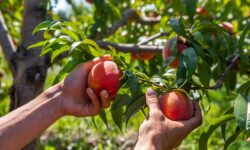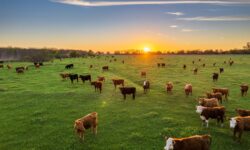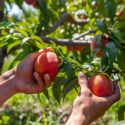Today, more food is grown on less land than ever before, but the number of people who are undernourished is increasing (1). Although research on this subject suggests that food insecurity has little to do with food production and is largely due to other factors, food production is predicted to become a major concern in the near future. Global agriculture must be able to address current food insecurity issues, while also feeding an estimated nine billion people by 2050 and adapting to climate change-related impacts (2).
To participate in creating an agricultural system that will produce enough to feed future generations, we must understand what is grown today, as well as how, and why it is grown. From this understanding, we can make consumption choices that support a sustainable future. To start, let’s explore why crops grown for human consumption only make up 55% of agricultural production (3). If only half of farms globally are growing food, then what are the rest growing and why?
Today’s agriculture
The other 45% of agriculture is growing feed and fuel. What does this mean?
Feed: As household incomes increase above poverty levels worldwide, diets are shifting from primarily plant-based to incorporate more animal products (4). This shift in diet has dramatic impacts on how arable land is used because “…animal products often require far more calories to produce than they end up contributing to the food system” (5). As demand for meat and dairy grows, animal agriculture is shifting away from raising livestock on large pastures to more efficient forms of production. This means livestock is being removed from pastures that cannot be used to grow crops for human consumption anyway, and being switched from a diet of grass to grain. This requires feed for the livestock to be grown on land that could instead be used to grow crops for direct human consumption (6). Today, livestock consumes roughly one third of global cereal production (7).
Fuel: As climate change mitigation becomes an increasing focus area for governments and businesses, there is growing interest in the replacement of fossil fuels with an organic substitute known as biofuels. Biofuels can be made from natural substances such as sugar cane, rapeseed, and corn (8). Biofuels are considered a climate change mitigation strategy as, contrary to fossil fuels, they are regenerative and do not release carbon dioxide that was previously stored deep underground.
Biofuels are controversial however for three main reasons:
- – They take up roughly 9% of agricultural production that could’ve been used to grow food (9).
- – The majority of biofuel crops are edible for humans (10).
- – Biofuels require a lot of resources to grow and they produce a lot of greenhouse gases through production and transportation that “essentially negates the perceived CO2 sequestration advantage” (11).
In short, our agricultural system today is far from being designed in a way that grows the most food possible and in the most sustainable way. One study estimated that “the U.S. agricultural system alone could feed 1 billion additional people by shifting crop calories to direct human consumption” (12).
What can you do
- – Change the way you eat meat: There are three ways you can do this. One, try reducing how much meat you eat. By doing so, you encourage agricultural production to grow crops that are for direct human consumption. Alternatively, replace beef with pork or chicken. This drastically reduces the amount of land and resources needed to produce your portion of meat. Lastly, look for grass-fed meat!
- – Reduce your reliance on fuel: While a hypothetical jury continues to decide whether or not biofuels are a better alternative to fossil fuels, try reducing your reliance on fuel all together! Where can you take a bike, carpool, or transit instead of driving on your own?
- – Love your food: Agricultural production will likely need to increase by 60-120% by 2050 in order to feed our growing population (13). Although you cannot control population growth on a day to day basis, you can control how much food you buy and how its stored. Did you know that 1/3 of all food is wasted (14)? If we formed better habits around food storage and use, our consumption rate as well as our grocery expenses, would go down!
Sources:
- 1. “The State of Food Security and Nutrition in the World 2019.” Food and Agriculture Organization of the United Nations, 2019. https://doi.org/10.18356/63e608ce-en.
- 2. Foley, Jonathan. “The Future of Food: A Five-Step Plan to Feed the World.” National Geographic. https://www.nationalgeographic.com/foodfeatures/feeding-9-billion/
- 3. Cassidy, Emily S., et al. “Redefining agricultural yields: from tonnes to people nourished per hectare.” Environmental Research Letters 8.3 (2013): 034015.
- 4. Christopher L. Delgado, Rising Consumption of Meat and Milk in Developing Countries Has Created a New Food Revolution, The Journal of Nutrition, Volume 133, Issue 11, November 2003, Pages 3907S–3910S, https://doi.org/10.1093/jn/133.11.3907S
- 5. Cassidy, Emily S., et al. “Redefining agricultural yields: from tonnes to people nourished per hectare.” Environmental Research Letters 8.3 (2013): 034015.
- 6. Ibid.
- 7. Mottet, Anne, et al. “Livestock: On our plates or eating at our table? A new analysis of the feed/food debate.” Global Food Security 14 (2017): 1-8.
- 8. Groom, Martha J., Elizabeth M. Gray, and Patricia A. Townsend. “Biofuels and biodiversity: principles for creating better policies for biofuel production.” Conservation biology 22.3 (2008): 602-609.
- 9. Cassidy, Emily S., et al. “Redefining agricultural yields: from tonnes to people nourished per hectare.” Environmental Research Letters 8.3 (2013): 034015.
- 10. Ibid.
- 11. Singh, Bharat P., ed. Biofuel crops: production, physiology and genetics. CABI, 2013.
- 12. Cassidy, Emily S., et al. “Redefining agricultural yields: from tonnes to people nourished per hectare.” Environmental Research Letters 8.3 (2013): 034015.
- 13. Ibid.
- 14. National Zero Waste Council. “Food Waste in Canada” Love Food Hate Waste. https://lovefoodhatewaste.ca/about/food-waste/
This Post Has 2 Comments
Comments are closed.












You know why chicken and pork take less land resources? Because they are cooped up in “living spaces” (though you can hardly call them that) that they can hardly turn around in. Pigs are kept in crates they can’t move in. Google pig crates. Why do you never see chickens (despite ALL the free range egg and chicken products you see on labels) and pigs when you drive through farm lands? Because they aren’t given a shred more of compassion or decency than you’d give if you were storing an actual inanimate object. They are stored like products, not like living beings. This is NOT an alternative to saving our planet. This is cruel, outdated, and unnecessary.
You said it yourself in this blog- “In short, our agricultural system today is far from being designed in a way that grows the most food possible and in the most sustainable way. One study estimated that “the U.S. agricultural system alone could feed 1 billion additional people by shifting crop calories to direct human consumption” (12). = STOP eating meat.
Hi Amelia,
Thank you for reaching out in regards to our recent blog about agricultural production, and thank you for your heart for animal welfare. We share a mission to create a sustainable and just food system.
Our article was in no means suggesting that animals should be kept in inhumane conditions in order to conserve arable land. Based on research found here, we were highlighting that the amount of food needed to feed pigs and chickens is much less than to feed cows. I apologize that the article offended you, that was definitely not our intention!
Thank you again for reaching out and for raising such an important conversation. I hope this clarifies our message.